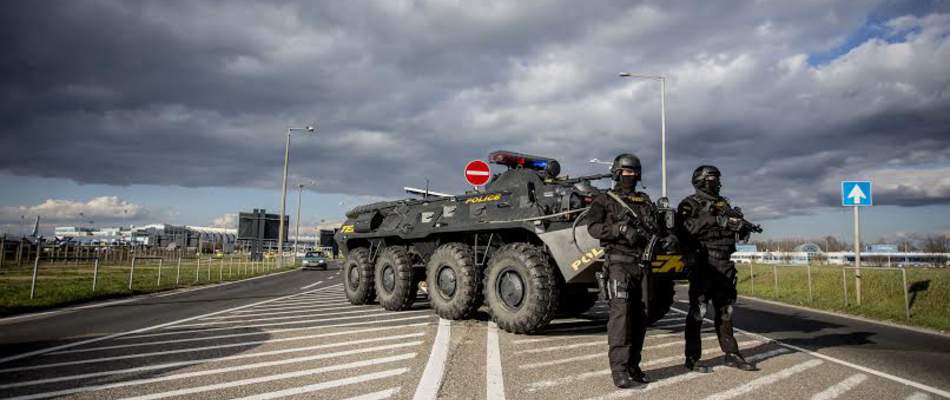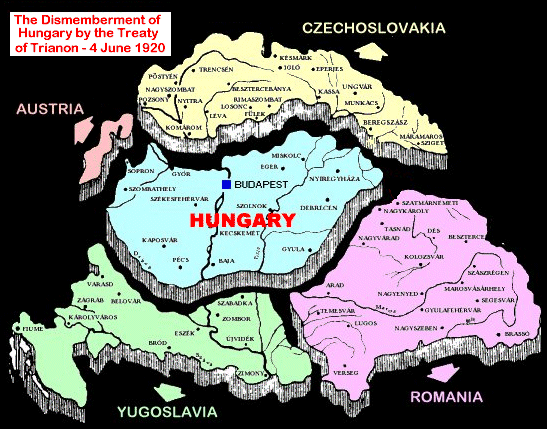When will Hungary get back its lost territories? – Trianon is 99 yrs old
The Peace Treaty of Trianon is one of the biggest Hungarian traumas from the previous century. It took away 2/3rd of Hungary’s territory while more than 3.3 million ethnic Hungarians became citizens of neighbouring countries hostile towards them. Since most of their problems are still not solved, the “Hungarian issue” is still present in the Carpathian Basin. Even today, the neighbouring countries would like to assimilate them while ethnic Hungarians want only some form of autonomy but not secession.
The Peace Treaty of Trianon was signed at 4:30 pm on June 4, 1920, by the Entente powers and Hungary. Historians agree that its provisions were not in balance with Hungary’s role in WWI (even Germany was punished lighter) and it served only the momentary interests of the Entente powers. For Budapest,
there was no choice but to sign
the treaty. If not, the political leadership risked the total disappearance of the country. However, the people rejected and hated it swearing a collective oath to do everything possible to change or even abolish it.
Trianon
remained a common trauma even today;
therefore, there are many misbeliefs regarding it. 24.hu collected some of these.
1. The peace treaty will expire in 2020
Of course, there is no ground for such expectations: there is no secret clause in it containing such provisions. Furthermore, the peace treaty is not in effect today since Hungary had to sign a new one after losing WWII. The peace treaty of Paris was created in 1947, and it reestablished the Trianon borders except for three villages near the actual Hungarian-Slovakian border which it gave to onetime Czechoslovakia.
Moreover, the Hungarian governments signed basic treaties with the neighbouring countries in the 90s in which they cleared that Budapest has and will have no territorial claims towards them and vice versa.
However, even today many believe in Hungary that
in 2020 all lost territories will suddenly return.
2. French PM Georges Clemenceau hated the Hungarians
Therefore, he took vengeance on them with Trianon – says the other widely accepted Hungarian misbelief. True, Clemenceau’s son married a Hungarian woman, Ida Michnay, they had two children but their spousehood went bad soon, and they divorced. However, the French PM
remained in a very good relationship with Ida,
moreover, his daughter-in-law lived in the Clemenceau castle until her death in 1983.
The origin of the gossip comes from the fact that Clemenceau was in the middle of his presidential campaign when he met the Hungarian peace delegation and since he was a very morose person he was very rude to them. Albert Apponyi, Pál Teleki and other Hungarian diplomats in Trianon were not used to the tone of the French PM, and therefore, they thought that he hates them.
However, they were not right; Clemenceau worked only for what he believed the national interest of France was. For example, he hated Romanian PM Ion Bratianu, but he gave Transylvania to Romania because he believed that a Greater-Romania behind the back of Germany is important for Paris.
3. Romanian prostitutes influenced the entente decision makers
This is a “good sounding” lie. In fact, the Romanian lobby was very powerful in Paris from the end of the 19th century, and it cannot be totally excluded that there were even Romanian prostitutes in the salons of the French youth. However, Historians all agree that this, of course, was not a decisive factor, at all.
Though we know that Romanian Queen Mary, a beautiful celebrity of her age,
met entente politicians,
and in March-April 1919 we also know that she did so to restore the reputation of PM Bratianu because the Entente powers resented Romania for its peace treaty of Bucharest on 1918 May with the central powers.
4. Czech politicians said that the Ipoly and the Ronyva are navigable rivers
Of course, they are not, but, also, the Czechs did not really tell this lie to Entente decision makers. Some assumed this because Prague wanted to gain even more land and thus they were thought to struggle for a more Southern borderline in Trianon. The reason behind the widely believed gossip is that the Czechs, the Romanians and the Serbs wanted to gain control over as many Hungarian railway lines as possible and the Entente powers backed this goal for obvious reasons.
In this case, the railway ran near the two rivers, and it was the only connection to Transcarpathia which was given to Czechoslovakia. This is how such a pathetic decision could be made as
Sátoraljaújhely remained part of Hungary while its railway station was given to Czechoslovakia.
5. The United States did not sign the Peace Treaty of Trianon because they believed it is very unjust
This cannot be true because the American delegation travelled home after the German peace treaty in 1919. Only a few American diplomats remained in Europe as observers. It is true that even though the American ambassador to Paris signed the treaty,
the Congress did not ratify it later.
But, actually, the US legislation did not ratify any of the treaties, and, of course, the Hungarian one was no exception. In fact, by the time the treaties should have been signed, the Republicans gained a majority in both houses, and they did not want to become part of the League of Nations.
Source: 24.hu
please make a donation here
Hot news
What happened today in Hungary? – 17 April, 2024
Orbán’s MEP talks about leaving Europe!
Hungarian foreign minister: Trinidad and Tobago key player in EU’s LNG supply 🔄
Phenomenal success: CNN selects Budapest metro line as the world’s best
Hate speech? PM Orbán in Brussels: Hungary does not want a mixed society!
Shocking: foreigners robbed Louis Vuitton store in Budapest, police caught them quickly – VIDEO, PHOTOS





21 Comments
John Wood, what is your reference that Hungary will get back its territories next year? Based on my knowledge it is just a fairytale. And what do you think, how it will happen?
The reality is that if Hungary were to somehow “get back” the territories it lost from Trianon, there would be much more non-Hungarians in the country than Hungarians. In short, if there was an election, Hungarians would lose. Hungary needs to concentrate on solving its population problem. Some models project that the population of Hungary, which is about 9,750,000 today may drop to as low as 6,500,000 by 2050 due to low birth rate and massive emigration of young people to Western Europe and elsewhere. This will be catastrophic for Hungary economically as well as from a national security point of view..
John woods, instead of apologizing for the raping of Hungary why don’t you research and share with the readers the monetary gifts, many of the politicians favouring the “new” countries received? How a country with historic blood ties to its territories, documented history and geographic territory was stolen by a bunch of cut throat thieves?
Dear Krisztian, I think you should read the article carefully because it is about misbeliefs regarding Trianon.
Dear alhorvath, the article is about misbeliefs regarding Trianon so it deals with the fact that many Hungarians believe even today that after 100 years (in 2020) the peace treaty will somehow expire (it is not in effect today but they do not care for the historical facts). We did not write anything about getting back territories.
Dear Edward, in the article it is clearly written that there was an effective lobby in favour of Romania, Serbia and Czechoslovakia in Paris. But it is also emphasized that this was not a decisive factor, great powers and mostly France decided based on what they thought their national interests are.
Thank you for responding Mr. Woods. . I agree , in part, that the Entente and mainly France and England pushed for the destruction of Hungary. I disagree that the lobby was not a decisive factor. Money will corrupt any decision. Lord Seton Watson, a great sympathiser of Czech, Slovak and Romania, pressed his influence upon the authors of Hungary’s destruction. Maps drawn up by the Czechs, Romanians and Serbs showed many falsehoods and claims. River names and place names were shown in every language but Hungarian. The bigger the lie and the louder you shout it, the easier it will be believed.,
The Treaty was not only pushed by Clemencaeu but others who hated Hungary and Hungarians. The pan-Slavic movement was aiming for Hungary’s destruction from the late 1800’s. So the treaty itself was already set into play years before. The players were only looking for the opportune time.
Hungary and the neighbors are in the EU , there are bigger powers in the world right now like USA or China. We are the laughing stock of the world , they know this union is a joke because after millenia of conflicts we learned nothing. We are free to learn, travel and work wherever we want in EU. Is our duty to change our mentallity and cooperate , if we dont it will be our demise.
It is so easy to declare that Hungarians do not understand the nature of the treaty and they can not accept their deserved reality. I do wish all the same to you dear winners what we got from you. I am really eager will you survive it or you will disappear. The process has begun you just did not realized yet.
John Woods, at least ONE HUGE WRONG IDEA about Hungary between 1867-1918 wasn’t shown in your article: Hungary was an EMPIRE and not a national state! Simple facts to prove that: 1) Non-Hungarian whole nations were ruled / administrated from (Buda)Pest , such as both Croatian, and Slovakian and important parts of other nations as Romanian and Serbian as well, ALL of them having been at that time MAJORITY of the inhabitants of Croatia, Slovakia, Transylvania etc. In other words, the lands claimed as “lost” by Hungary WERE NOT HUNGARIAN, so Hungary lost something that didn’t belong to it! So, the trauma and tragedy is actually just a post imperial situation, similar to that of old empire that ruled different parts of the world during human history. Tens of empires raised and then disappeared, so why should the death of Hungarian empire something so cruel and / or unfair comparing to other empires? On the other hand, Hungarian ethnicity people in the kingdom of Hungary were a MINORITY actually, according to the census made by the Hungarian administration itself in 1869, [….] 1900 and 1910. People conscripted as German language native speakers were counted as Hungarian, similarly Israelite religion people (about 5% of the whole kingdom’s population) were counted as Hungarian as well. These so-called “new Hungarians” included in Hungarian ethnicity people helped “Hungary” to claim there was a Hungarian “majority” (less over 50% with 5% Jewish people included!) in 1910′ census, but never before. It doesn’t say anything about the Hungarian state forcing people to change their old German, Slovakian, Croatian, Serbian, Romanian names and adopt Hungarian ones as a patriotic attitude. The census in 1900 and 1910, if attentively examined, reveal also situations when people who declared they were able to speak Hungarian were counted as “Hungarian”, in spite of their declared different ethnicity, mother language or religion. To cut a long story short, Hungarians had been a minority in the Kingdom of Hungary from the Austrian-Hungarian monarchy, which kingdom was itself an EMPIRE, not a national state. 2) People living under the rule of (Buda) Pest had not been asked whether they agreed that or not, that part of the former Habsburgs’ Empire, created by force and military conquers was yield by Vienna Court to the Hungarian aristocracy in order to make it support the almost deceased empire due to the defeat from Koniggraetz / Sadova (1866) . That way Vienna associated (Buda) Pest to ruling the empire. So, that Hungary was not a democratic state, was not a (con) federation of free nations that had agreed to live together in the same borders, but an imperial state that ruled subjected nations. Those nations chose to separate from Hungary in 1918 (because they were extremely pleased by the way they had been treated in the “nationalities’ paradise” during 1867-1918) and lead themselves by their own leaders in their own countries / lands. So, the Treaty of Trianon admitted the claims of for the former oppressed people in Hungary that gained their freedom in 1918 to be fair. That means that Trianon treaty made JUSTICE for those nations / people by separating them from the Hungarian oppressive state. The treaty made also JUSTICE for Hungary itself, because it gave Hungary its ethnic borders.
You’re an ignorant propagandist Iulian, the moment you stated Hungary was an “Empire” is when I stopped reading the rest of your garbage.
Hungary never gained any of its territory through imperialism, it’s borders remained more or less the same from the Middle Ages to the early 20th century.
As far as the many ethnicities that inhabited the Kingdom of Hungary…The Habsburgs who took control of Hungary in the 17th century after the Turks were driven out colonized millions of foreigners, Germans, Slovaks, Romanians into the depopulated, devastated areas…tripling Hungary’s population from 3 million to 9 million turning the Magyar into a minority in their own country.
Please take your lies [romanian] and place them where they belong.
So, as a man from Banat my perspective is a different one, dear all. I do consider the collapse of A-H Monarchy, the Trianon and the partition of Banat as the death of our civilisation, and the enslavement of all the ethnic groups from Banat to the Romanian corrupt administration. Romanians from Banat have bitter taste about what Romania means to them after 1920. Corruption, nepotism, looting and destruction to summarise some of them. Romania gain two great civilisations, Transylvania and Banat, and they transformed them in two enslaved regions with pauperised citizens. In essence one might aclaim one land by his achievements, we see none from that Romanian time.
The kingdom of hungaria conquered by force the teritories that later lost at Trianon . hungaria abused the people leaving in those teritories. hungaria treated Romanians, Serbians, Slovakians and other nationalityes worse than slaves . The only thing hungarians ar good at is to be served and licked in the ass by others in order hungarians to become greater .
hungaria can prosper only if it has slaves .
Czechoslovakia was the only one that wanted railways, not the others. If the Czechoslovakians never asked for railways. There wouldn’t be any changes with the border of Hungary-Czechoslovakia. They would just ask for war reparation. The Hungarian’s didn’t slave other ethnics. They leaved them do what they wanted. The Hungarian’s, including Hungarian family’s, children’s, etc were discriminated & slaved by the Romanian mostly. The Yugoslavian’s did discriminate the Hungarian’s not that much. The Hungarian’s also couldn’t have their own rights.
This is what I would say a better treaty of Trianon here:
Carpatho-Ukraine declares independence & Hungarians & Czechoslovakians have access through railways for trades & resource transportation.
Szerkerland will also declare independence under Romanian administration for certain areas where ethnic majorities Romanians are.
The Hungarian’s will have their own rights & discrimination won’t be tolerated.
Yugoslavia will annex its majority ethnic area. While the Hungarian’s keep there ethnic majority area in Banat or in Yugoslavia.
a
HUNGARY IS NOT MAGYARY! THINK DEEPER
HUNGARY WAS NOT AND STIL IS NOT MAGYARY
Term magyar was firt used in 1797!
Now let me tell you that it was indeed a romanian whore who influenced the outcome
Her name was Sugi Pula google it
Now cope and seethe
I am a Romanian, currently living in Transylvania. And I’d say Hungary should get all of it’s territory back (including Transylvania). I know this is unexpected coming from a Transylvanian Romanian but I checked all the territories taken from Hungary and they all have Hungary’s tradition and culture. And when I look around my county this is what I see: Hungarian style houses, found a village with people making Langos and serving to you, etc.
In conclusion all of the lost territories still have Hungarian culture and get back where it belongs. Then I would decide if I remain in Hungary or move to the remaining part of Romania.
Update on my opinion about Hungary getting back it’s lost territories: First of all let me clarify that I don’t know how it is in other countries so I will just say some things about why Hungary should get the territories back, in Transylvania I heard most of the villages are either Hungarian or German settlements, sad to say this but Hungarians are cleaner and care more about their villages than Romanians, the villages Romanians took over are not as clean and don’t look good aesthetically while other more Hungarian villages are more clean and taken care of.
Forgot to mention (for all European countries): We should somehow send the Romani (not same thing as Romanians) back to India.
If Hungary gets all of the lands back they should try to make the Romani people go to India and somehow encourage others to increase Hungarian birth life so they can populate the “new” lands.